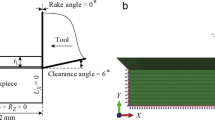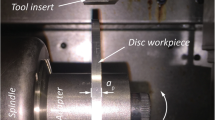Abstract
The chip transition from continuously serrated to discontinuously segmented is one of the most fundamental and challenging problems in metal cutting. In this work, a reliable finite element model for high speed cutting of Ti-6Al-4 V was developed based on the high speed cutting experiments. The Johnson–Cook (J-C) constitutive parameters of the Ti-6Al-4 V were optimized using the response surface method (RSM) and multi-objective genetic algorithm to accurately describe the plastic behavior of Ti-6Al-4 V alloy in high speed cutting. With using the optimized constitutive parameters, the simulated chip morphologies and cutting forces match well with the experimental results in a wide range of cutting speed from 0.05 to 86.5 m/s. The formation mechanism of the discontinuously segmented chip was further studied based on the validated finite element model. The results reveal that three distinct cracks form successively in the segmented chip formation process: crack I forms at the chip root, cracks II and III initiate at the primary shear zone center and chip-free surface respectively and propagate along the direction of maximum stress triaxiality to seperate the chip and workpiece. Crack I, which forms at the chip root due to the maturely evolved shear banding, is the key reason for the transition of chip formation from continuously serrated to discontinuously segmented.


















Similar content being viewed by others
References
Atkins T (2009) The science and engineering of cutting: the mechanics and processes of separating, scratching and puncturing biomaterials, metals and non-metals. Butterworth-Heinemann/Elsevier, Amsterdam. https://doi.org/10.1016/C2009-0-17178-7
Aydin G, Karakurt I, Aydiner K (2012) Performance of abrasive waterjet in granite cutting: influence of the textural properties. J Mater Civil Eng 24:944–949. https://doi.org/10.1061/%28ASCE%29MT.1943-5533.0000459
Celep O, Aydin G, Karakurt I (2013) Diamond recovery from waste sawblades: a preliminary investigation. Proc Inst Mech Eng Part B J Eng Manuf 227:917–921. https://doi.org/10.1177/0954405412471524
Li A, Zhao J, Hou G (2017) Effect of cutting speed on chip formation and wear mechanisms of coated carbide tools when ultra-high-speed face milling titanium alloy Ti-6Al-4V. Adv Mech Eng 9:1–13. https://doi.org/10.1177/1687814017713704
Wang B, Liu Z, Cai Y, Luo X, Ma H, Song Q, Xiong Z (2021) Advancements in material removal mechanism and surface integrity of high speed metal cutting: a review. Int J Mach Tools Manuf 166:103744. https://doi.org/10.1016/j.ijmachtools.2021.103744
Ma W, Chen X, Shuang F (2017) The chip-flow behaviors and formation mechanisms in the orthogonal cutting process of Ti6Al4V alloy. J Mech Phys Solids 98:245–270. https://doi.org/10.1016/j.jmps.2016.07.023
Barry J, Byrne G (2002) The mechanisms of chip formation in machining hardened steels. J Manuf Sci E-T ASME 124:528–535. https://doi.org/10.1115/1.1455643
Friderikos O, Sagris D, David CN, Korlos A (2020) Simulation of adiabatic shear bands in orthogonal machining of Ti6Al4V using a rigid-viscoplastic finite element analysis. Metals 10:1–29. https://doi.org/10.3390/met10030338
Wu H, To S (2015) Serrated chip formation and their adiabatic analysis by using the constitutive model of titanium alloy in high speed cutting. J Alloy Compd 629:368–373. https://doi.org/10.1016/j.jallcom.2014.12.230
Kountanya R, Al-Zkeri I, Altan T (2009) Effect of tool edge geometry and cutting conditions on experimental and simulated chip morphology in orthogonal hard turning of 100Cr6 steel. J Mater Process Technol 209:5068–5076. https://doi.org/10.1016/j.jmatprotec.2009.02.011
Wang H, To S, Chan CY, Cheung CF, Lee WB (2010) A study of regularly spaced shear bands and morphology of serrated chip formation in microcutting process. Scripta Mater 63:227–230. https://doi.org/10.1016/j.scriptamat.2010.03.059
Wang H, To S, Chan CY, Cheung CF, Lee WB (2010) Elastic strain induced shear bands in the microcutting process. Int J Mach Tools Manuf 50:9–18. https://doi.org/10.1016/j.ijmachtools.2009.10.002
Molinari A, Musquar C, Sutter G (2002) Adiabatic shear banding in high-speed machining of Ti-6Al-4V: experiments and modeling. Int J Plasticity 18:443–459. https://doi.org/10.1016/S0749-6419(01)00003-1
Duan CZ, Zhang LC (2012) Adiabatic shear banding in AISI 1045 steel during high speed machining: mechanisms of microstructural evolution. Mat Sci Eng A-Struct 532:111–119. https://doi.org/10.1016/j.msea.2011.10.071
Wang H, To S, Chan CY, Cheung CF, Lee WB (2011) Dynamic modelling of shear band formation and tool-tip vibration in ultra-precision diamond turning. Int J Mach Tools Manuf 51:512–519. https://doi.org/10.1016/j.ijmachtools.2011.02.010
Gu L (2019) Experimental and theoretical study on energy convergence characteristics of adiabatic shear fracture process in high-speed machining of hardened stainless steel. Int J Adv Manuf Technol 103:2917–2928. https://doi.org/10.1007/s00170-019-03458-y
Joshi SS, Ramakrishnan N, Ramakrishnan P (2001) Micro-structural analysis of chip formation during orthogonal machining of Al/SiCp composites. J Eng Mater-T ASME 123:315–321. https://doi.org/10.1115/1.1356026
Sutter G, List G (2013) Very high speed cutting of Ti–6Al–4V titanium alloy – change in morphology and mechanism of chip formation. Int J Mach Tools Manuf 66:37–43. https://doi.org/10.1016/j.ijmachtools.2012.11.004
Davis B, Dabrow D, Ju L, Li A, Xu C, Huang Y (2017) Study of chip morphology and chip formation mechanism during machining of magnesium-based metal matrix composites. J Manuf Sci E-T ASME 139:1–34. https://doi.org/10.1115/1.4037182
Gu L, Wang M (2018) Adiabatic shear fracture prediction in high-speed cutting at various negative rake angles and feeds. Adv Manuf 6:41–51. https://doi.org/10.1007/s40436-018-0212-2
Liu H, Zhang J, Xu X, Zhao W (2018) Experimental study on fracture mechanism transformation in chip segmentation of Ti-6Al-4V alloys during high-speed machining. J Mater Process Technol 257:132–140. https://doi.org/10.1016/j.jmatprotec.2018.02.040
Yang J, Sun S, Brandt M, Yan W (2011) 3D finite element modeling of the machining of Ti6Al4V alloys. Adv Mater Res 189–193:1926–1929. https://doi.org/10.4028/www.scientific.net/AMR.189-193.1926
Wang B, Zhan Qiang L, Hou X, Zhao JF (2018) Influences of cutting speed and material mechanical properties on chip deformation and fracture during high-speed cutting of Inconel 718. Materials 11:1–16. https://doi.org/10.3390/ma11040461
Guo YB, Yen DW (2004) A FEM study on mechanisms of discontinuous chip formation in hard machining. J Mater Process Technol 155–156:1350–1356. https://doi.org/10.1016/j.jmatprotec.2004.04.210
Lin ZC, Lo SP (2001) 2-D discontinuous chip cutting model by using strain energy density theory and elastic-plastic finite element method. Int J Mech Sci 43:381–398. https://doi.org/10.1016/S0020-7403(00)00015-1
Umbrello D (2008) Finite element simulation of conventional and high speed machining of Ti6Al4V alloy. J Mater Process Technol 196:79–87. https://doi.org/10.1016/j.jmatprotec.2007.05.007
Hao Z, Li J, Fan Y, Ji F (2019) Study on constitutive model and deformation mechanism in high speed cutting Inconel718. Arch Civ Mech Eng 19:439–452. https://doi.org/10.1016/j.acme.2018.11.009
Childs THC, Arrazola P-J, Aristimuno P, Garay A, Sacristan I (2018) Ti6Al4V metal cutting chip formation experiments and modelling over a wide range of cutting speeds. J Mater Process Technol 255:898–913. https://doi.org/10.1016/j.jmatprotec.2018.01.026
Ye GG, Xue SF, Ma W, Dai LH (2017) Onset and evolution of discontinuously segmented chip flow in ultra-high-speed cutting Ti-6Al-4V. Int J Adv Manuf Technol 88:1161–1174. https://doi.org/10.1007/s00170-016-8847-2
Ye G, Xue S, Ma W, Jiang M, Ling Z, Tong X, Dai L (2012) Cutting AISI 1045 steel at very high speeds. Int J Mach Tools Manuf 56:1–9. https://doi.org/10.1016/j.ijmachtools.2011.12.009
Li J, Tao Z, Cai X, An Q, Chen M (2020) Experimental and finite element analysis of the formation mechanism of serrated chips of nickel-based superalloy Inconel 718. Int J Adv Manuf Technol 107:4969–4982. https://doi.org/10.1007/s00170-020-05150-y
Zhang J, Xu X, Outeiro J, Liu H, Zhao W (2020) Simulation of grain refinement induced by high-speed machining of OFHC copper using cellular automata method. J Manuf Sci E-T ASME 142:1–13. https://doi.org/10.1115/1.4047431
Johnson GR, Cook WH (1983) A constitutive model and data for metals subjected to large strains, high strain rates and high temperatures. Eng Fract Mech 21:541–548
Johnson GR, Cook WH (1985) Fracture characteristics of three metals subjected to various strains, strain rates, temperatures and pressures. Eng Fract Mech 21:31–48
Zhang YC, Outeiro JC, Mabrouki T (2015) On the selection of Johnson-Cook constitutive model parameters for Ti-6Al-4V using three types of numerical models of orthogonal cutting. In: 15th CIRP Confer Model Mach Oper 31:112–117. https://doi.org/10.1016/j.procir.2015.03.052
Löschner P, Jarosz K (2019) Investigation of the effect of Johnson-Cook constitutive model parameters on results of the FEM turning simulation. In: Hloch S, Klichová D, Krolczyk G, Chattopadhyaya S, Ruppenthalová L (eds) Advances in manufacturing engineering and materials. Springer, Cham, pp 315–323. https://doi.org/10.1007/978-3-319-99353-9_34
Box GEP, Draper NR, Myers RH, Montgomer DC, Khuri AI, Cornell JA (1998) Empirical model building and response surface. J Am Stat Assoc 93:401–402
Dikshit MK, Puri AB, Maity A (2017) Modelling and application of response surface optimization to optimize cutting parameters for minimizing cutting forces and surface roughness in high-speed, ball-end milling of Al2014-T6. J Braz Soc Mech Sci Eng 39:5117–5133. https://doi.org/10.1007/s40430-017-0865-y
Acknowledgements
This work was supported by the National Natural Science Foundation of China (11972376), the Natural Science Foundation of Shandong Province (ZR2019MA007), the Fundamental Research Funds for the Central Universities (22CX03014A), and the Innovation Fund Project for Graduate Students of China University of Petroleum (YCX2021095).
Author information
Authors and Affiliations
Contributions
GGY: conceptualization, writing—review & editing, supervision. XJL: methodology, software, writing—original draft. PZ: software. SFX: project administration. YZ: investigation. XGH: validation.
Corresponding author
Ethics declarations
Conflict of interest
The authors declare no competing interests.
Additional information
Publisher's Note
Springer Nature remains neutral with regard to jurisdictional claims in published maps and institutional affiliations.
Rights and permissions
Springer Nature or its licensor (e.g. a society or other partner) holds exclusive rights to this article under a publishing agreement with the author(s) or other rightsholder(s); author self-archiving of the accepted manuscript version of this article is solely governed by the terms of such publishing agreement and applicable law.
About this article
Cite this article
Ye, G., Li, X., Zhang, P. et al. The formation mechanism of discontinuously segmented chip in high-speed cutting of Ti-6Al-4 V. Int J Adv Manuf Technol 130, 1477–1493 (2024). https://doi.org/10.1007/s00170-023-12817-9
Received:
Accepted:
Published:
Issue Date:
DOI: https://doi.org/10.1007/s00170-023-12817-9




